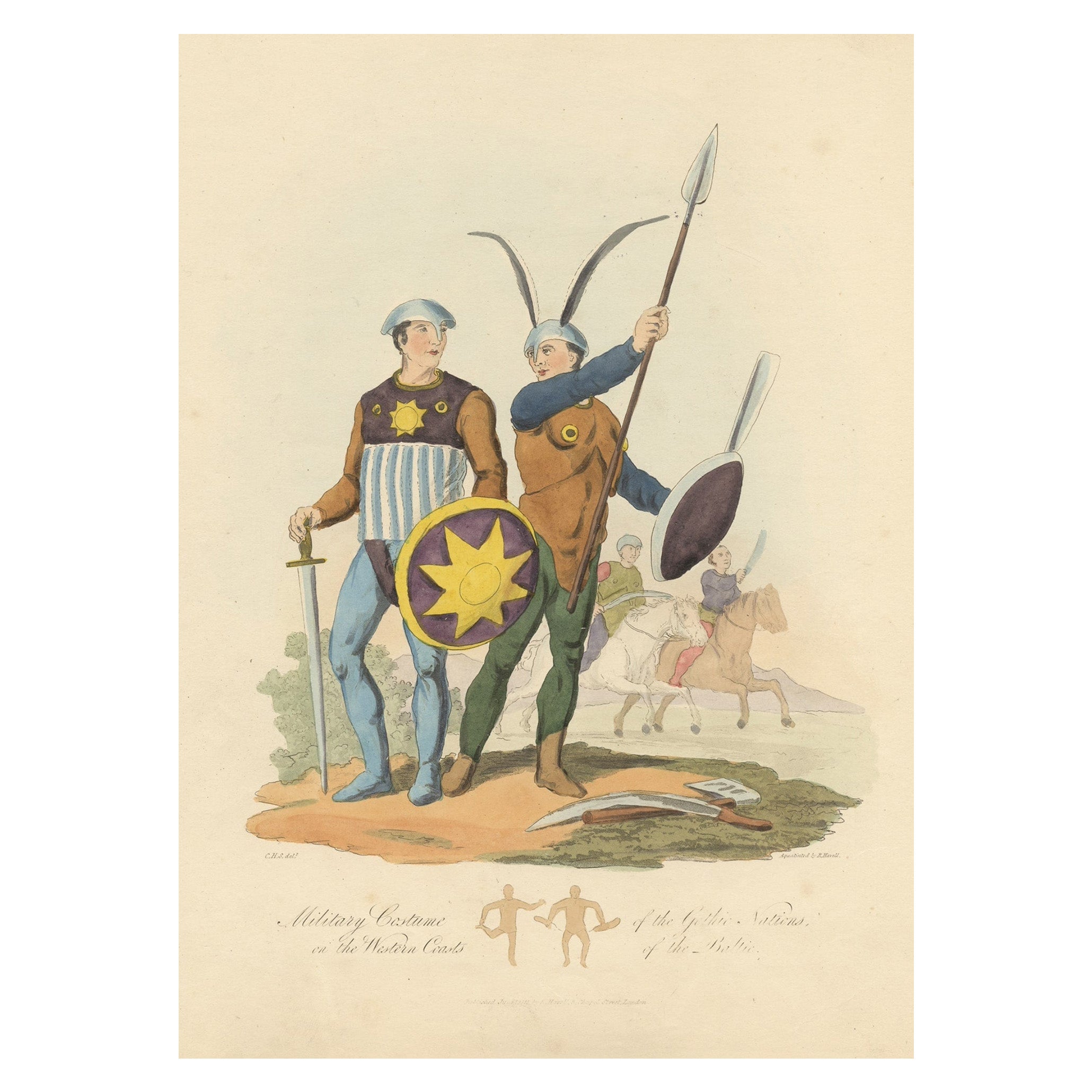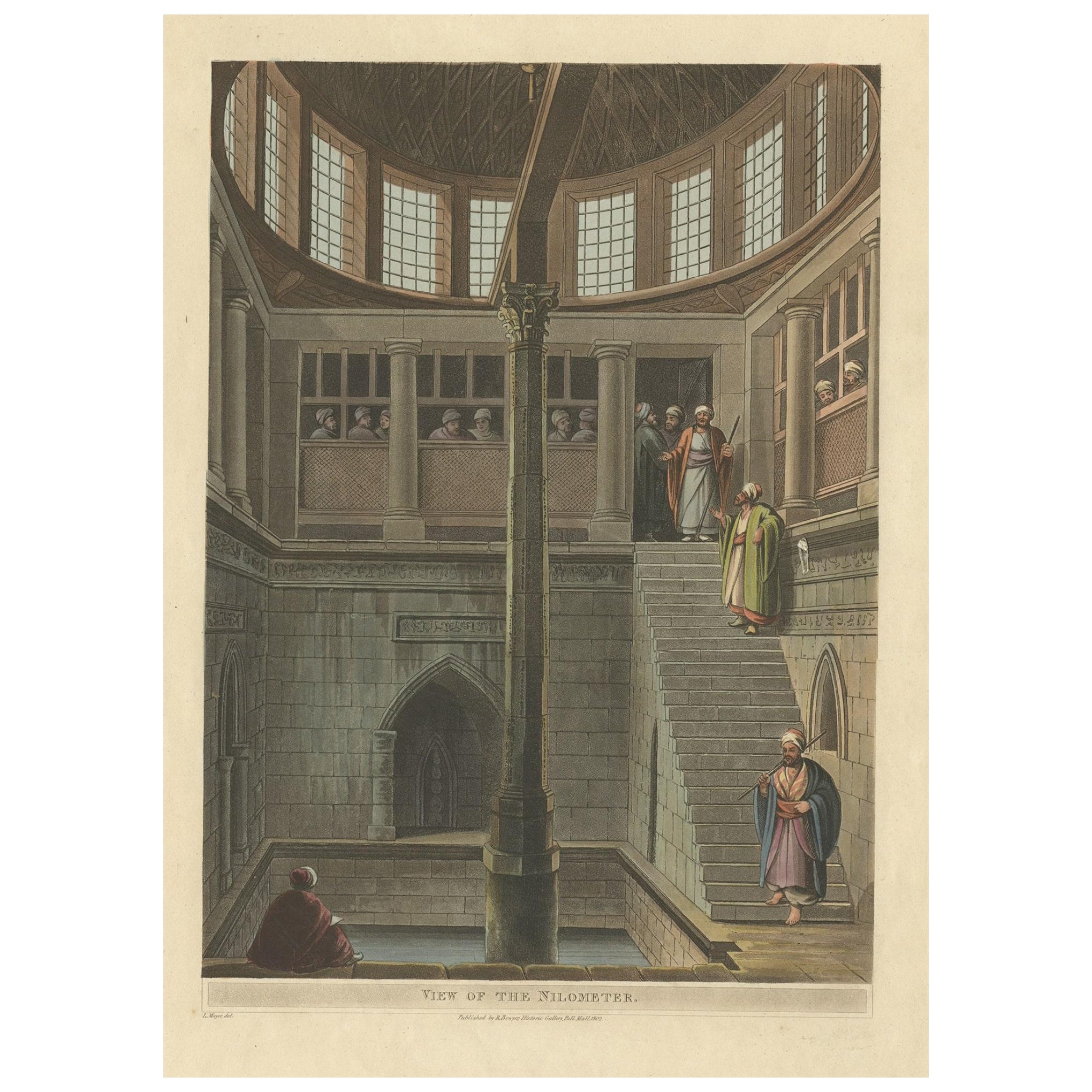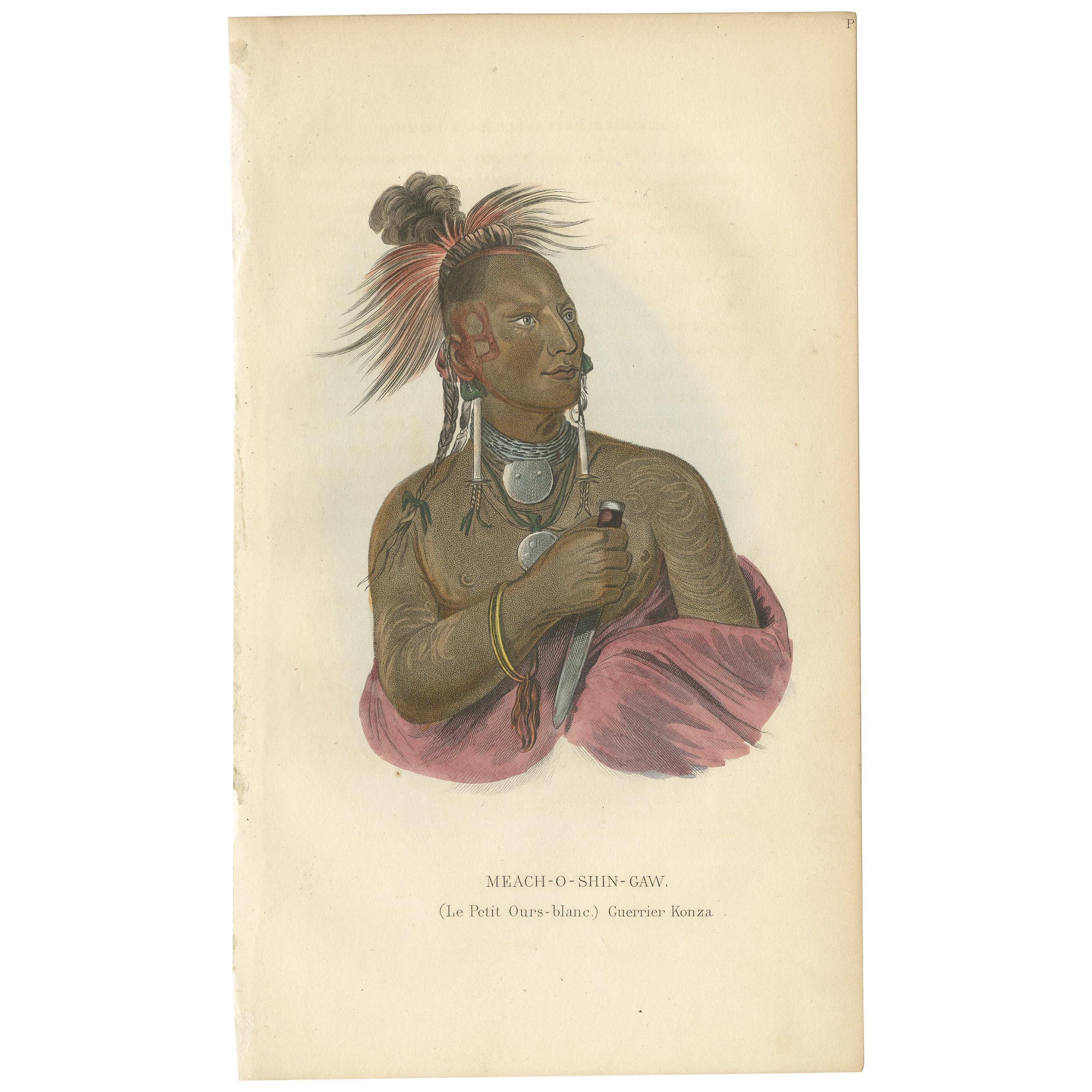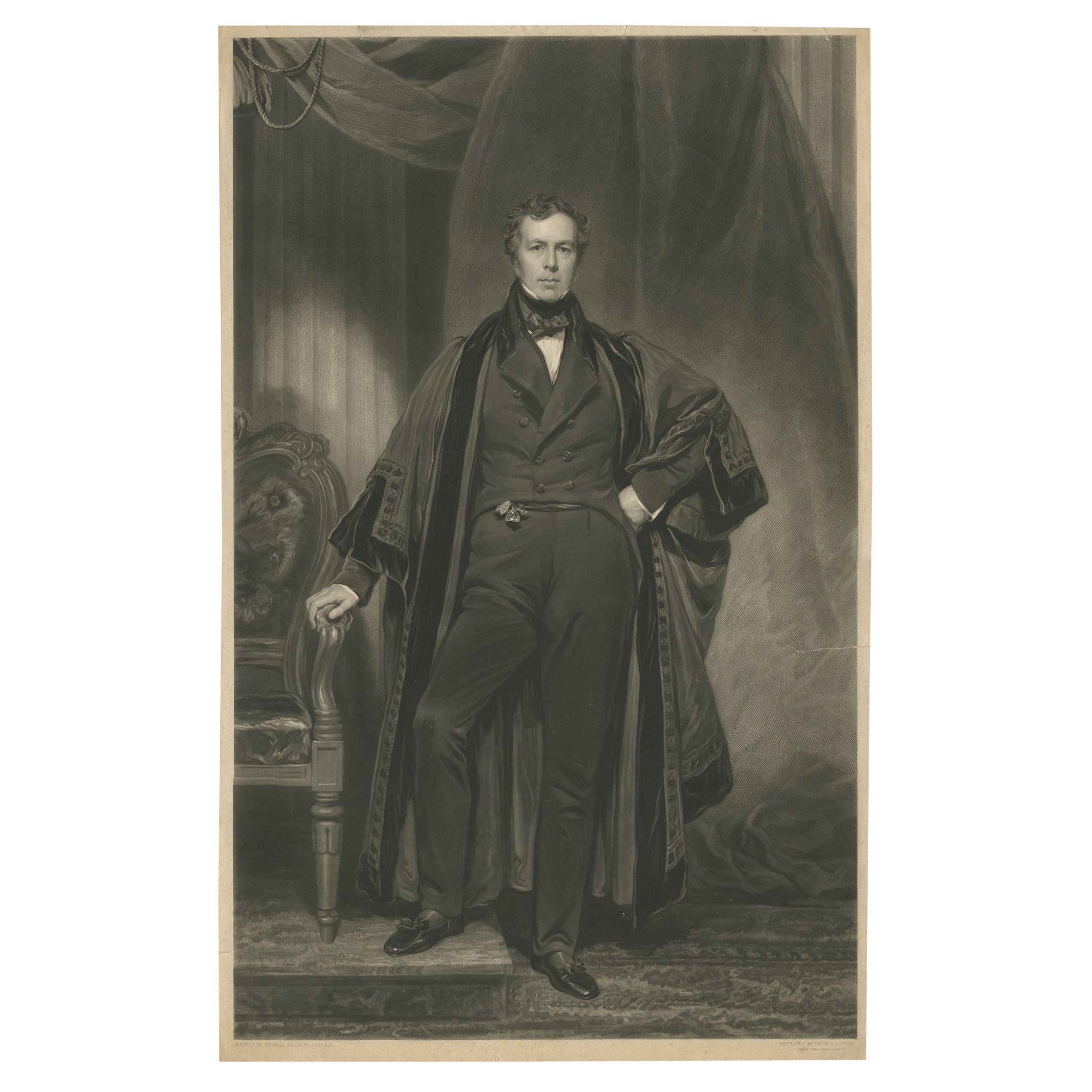Items Similar to The First Australian Tourist to Visit England: Bennelong of the Eora Nation 1802
Want more images or videos?
Request additional images or videos from the seller
1 of 6
The First Australian Tourist to Visit England: Bennelong of the Eora Nation 1802
About the Item
The engraving by Samuel Neele, titled "Portrait of Bennilong," is a significant historical representation from G. A. Cooke's "Modern and Authentic System of Universal Geography," published in circa 1802.
It portrays Bennelong, an Eora man from New Holland (now Australia), who learned English and traveled to England with Governor Arthur Phillip in 1792. This image reflects Bennelong's unique position as a cultural intermediary and is a remarkable example of early cross-cultural encounters between Indigenous Australians and Europeans.
Some more interesting facts about Woollarawarre Bennelong from an article in the Independent of March 2011:
The grave of Woollarawarre Bennelong, an Aboriginal leader who played a key role in early Australian colonial history, has been discovered in a suburban front garden – solving a 200-year-old mystery.
One of the first Aborigines to interact with British colonists, Bennelong – a senior member of the Wangal tribe – struck up a friendship with the first governor of New South Wales, Arthur Phillip. When Phillip sailed home to England, he took the Wangal man with him, dressed him in Regency finery and introduced him to London high society. When Bennelong returned to Australia, he was ostracised by the indigenous and European communities. In 1813, having sunk into alcoholism, he died – but exactly where he was buried has been the subject of speculation ever since.
Now, after protracted detective work by an environmental scientist, Peter Mitchell, Bennelong's final resting-place has been found, The Sun-Herald newspaper reported yesterday. The discovery represents the missing link in Bennelong's extraordinary story, and is certain to reignite interest in a man who tried to bridge the gap between black and white – a challenge still facing Australians today.
Dr Mitchell, the honourary associate professor of physical geography at Sydney's Macquarie University, scoured the archives for references to the grave, which he matched against geographical records to place it in the Sydney suburb of Putney. Surveyors from the local Ryde Council then pinpointed its location, between a front lawn and a central reservation.
Before urban sprawl took over, the area was part of the estate of James Squire, Australia's first commercial brewer, who has given his name to a line of popular modern beers. An ex-convict, Squire befriended Bennelong before he died and buried him in his own orchard.
The precise location of the grave is being kept secret, until Aboriginal leaders have been consulted about the next steps. Ryde Council wants to use ground-penetrating equipment to explore the site. A Ryde councillor, Vic Tagg, described the find as "fantastic", saying it would rewrite history.
Relations between Bennelong and Phillip got off to an unpromising start in 1789, nearly two years after the First Fleet arrived in Sydney Cove. Curious to learn more about Aboriginal language and customs, Phillip had a group of men kidnapped while they were fishing in Manly, on the northern side of the harbour.
All escaped within a week, except Bennelong, who spent six months living in Government House. Phillip gave him European clothes, taught him English and introduced him to the finer points of table etiquette. A First Fleet captain, Watkin Tench, described him as "about 26 years old, of good stature and stoutly made with a bold intrepid countenance which bespoke defiance and revenge".
After Bennelong, too, ran away, Phillip tracked him down and the friendship was re-established – despite an unfortunate incident in which Phillip got speared in the shoulder by a fellow tribesmen of Bennelong.
A cultural intermediary, Bennelong encouraged the British to learn the Wangals' language and customs. Phillip had a brick hut built for his friend on a peninsula now known as Bennelong Point, the site of the Sydney Opera House. And when he returned to England in 1792, he took Bennelong and another man, Yemmerrawannie, with him, and – as anecdote has it – presented them to King George III. Whether that happened is contested by historians. But certainly the pair – decked out in the breeches, buckled shoes, ruffled lace shirts and waistcoats of that period – became popular guests in the salons of the rich and famous. And while the idea of them being paraded around seems tasteless now, they reportedly found London as exotic and fascinating as London found them.
The men boarded in Grosvenor Square, in Mayfair, where they were attended by barbers and servants. They saw a play at the Covent Garden Theatre and went to the opera. They visited the Tower of London and St Paul's Cathedral, and looked in on the trial of Warren Hastings, a former governor of Bengal who was being impeached. "They were the first Australian tourists," according to one historian.
Bennelong adopted English manners; he "bowed, toasted, paid the ladies compliments and loved wine", according to one account.
But he grew increasingly ill and homesick, particularly after his friend died of pneumonia. In 1795 he sailed back to Australia. But relations between black and white had deteriorated and he was shunned by Aborigines and Australians. He died a lonely alcoholic, but his legacy survives.
This is a circa 1801 or 1802 copperplate engraving from George Alexander Cooke's "Universal Geography" .
The print is part of George Alexander Cooke's comprehensive work "A Modern and Authentic System of Universal Geography." This book was a significant compilation of geographical knowledge during the late 18th century, offering descriptions and accounts of various parts of the world, influenced by the age of exploration. It includes narratives of famed explorers like Captain James Cook and Ferdinand Magellan, detailing their discoveries and journeys that expanded the European understanding of the globe. Cooke's work served as both a chronicle and reference for the territories and cultures encountered by these voyagers.
- Dimensions:Height: 10.44 in (26.5 cm)Width: 7.88 in (20 cm)Depth: 0 in (0.02 mm)
- Materials and Techniques:Paper,Engraved
- Period:
- Date of Manufacture:circa 1801
- Condition:Good. Aged paper with typically warm, yellowish-brown hue. Some of the text is frayed. This is not a reproduction but an original engraving. Study the image carefully.
- Seller Location:Langweer, NL
- Reference Number:
About the Seller
5.0
Platinum Seller
These expertly vetted sellers are 1stDibs' most experienced sellers and are rated highest by our customers.
Established in 2009
1stDibs seller since 2017
1,916 sales on 1stDibs
Typical response time: <1 hour
- ShippingRetrieving quote...Ships From: Langweer, Netherlands
- Return PolicyA return for this item may be initiated within 14 days of delivery.
More From This SellerView All
- Early Map of Sydney with Botany Bay, Port Jackson & Broken Bay, Australia, 1802Located in Langweer, NLInteresting chart of the three harbours of Botany Bay, Port Jackson, and Broken Bay showing the ground cultivated by the colonists. In the early days of the settlement in Australia t...Category
Antique Early 1800s Maps
MaterialsPaper
- Military Costume of the Gothic Nations on the Western Coasts of the Baltic, 1815Located in Langweer, NLAntique print titled 'Military Costume of the Gothic Nations on the Western Coasts of the Baltic'. Old print of Baltic military costumes. Originates from 'The costume of the origin...Category
Antique 1810s Prints
MaterialsPaper
- Antique Map of England and Wales, with References to the CountiesLocated in Langweer, NLAntique map titled 'England and Wales'. Original antique map of England and Wales, with references to the counties. Source unknown, to be determined. Published circa 1820.Category
Antique Early 19th Century Maps
MaterialsPaper
- Rare Print of a Nilometer, a Structure Used to Calculate Taxes in Egypt, 1802Located in Langweer, NLHow high is the water, mama? Johny Cash was asking his mother, when it is was '6 feet high and rising'. In Egypt it would probably mean that taxes that year would be low. In Egypt it all depended on the behavior of the Nile and a Priest, who would monitor the so-called Nilometer. A nilometer was a structure for measuring the Nile River's clarity and water level during the annual flood season. If the water level was low, there would be less food. If it was too high, it would be destructive. There was a specific mark that indicated how high the flood should be if the fields were to get good soil. Their predictions would determine how much money...Category
Antique Early 1800s Scientific Instruments
MaterialsPaper
- Antique Print of a Warrior of the Kaw Nation by Prichard '1843'Located in Langweer, NLAntique print titled 'Meach-O-Shin-Gaw'. Lithograph of a warrior of the Kaw Nation. The Kaw Nation (or Kanza or Kansa) are a federally recognized Native Ameri...Category
Antique Mid-19th Century Prints
MaterialsPaper
- Portrait of William Wallace Currie, First Mayor of Liverpool, England, 1837Located in Langweer, NLUntitled mezzotint of William Wallace Currie. William Wallace Currie was the first "Mayor of Liverpool" under the Municipal Corporations Act 1835. Artists and Engravers: Engraved by Thomas Lupton after a painting by Thomas Phillips...Category
Antique 1830s Prints
MaterialsPaper
You May Also Like
- Chart of the East Coast of EnglandLocated in Norwell, MAChart of the East Coast of England, from Dungeness to Flamborough, including the entrances to the Thames River. Drawn by hydrographer J.W. Norie in 1841. Includes Kent, Essex and Suf...Category
Antique 1840s English Nautical Objects
MaterialsPaper
- The First of September "Morning" Engraving, 1799Located in Carmel, CAMezzotint engraving, 1799, The First of September, after painting by George Moreland. Moreland was a noted London landscape and genre painter. By the...Category
Antique 1790s English Georgian Prints
MaterialsPaper
- Original Antique Print of Insects, Dated 1802Located in St Annes, LancashireGreat image of insects Copper-plate engraving by Milton Published by Longman & Rees, London Dated 1802 Unframed. Free shipping.Category
Antique Early 1800s English Georgian Prints
MaterialsPaper
- Original Antique Print of Butterflies, Dated 1802Located in St Annes, LancashireGreat image of butterflies Copper-plate engraving by Milton Published by Longman & Rees, London Dated 1802 Unframed. Free shipping.Category
Antique Early 1800s English Georgian Prints
MaterialsPaper
- Frontespice "The Mansions of England in the Olden Time"By Joseph NashLocated in Alessandria, PiemonteST/218-1 - Antique English print by Joseph Nash (1809-1878), famous British painter, member of the Gothic Revival Group. In 1838 he published the Revival Lithographic Collection "Medieval...Category
Antique Mid-19th Century English Other Prints
MaterialsPaper
- John Boultbee "The Durham Ox", hand coloured engraving dated 1802, EnglishLocated in Central England, GBThis rare engraving by John Whessell (c 1760 - 1840) was published in 1802 by John Day and is extensively inscribed below: “To the Right Honorable Lord Somerville. This print is...Category
Antique Early 1800s English George III Prints
MaterialsPaper





